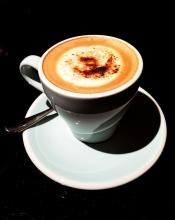Introduction to the coffee flavor and taste of Papua New Guinea Paradise Bird Manor with bright sour aroma.
Papua New Guinea is the second largest country in the South Pacific after Australia in population and area. It consists of New Guinea in the north and Papua in the south. It borders the province of Irian Jaya in Indonesia to the west and faces Australia across the Torres Strait to the south. It belongs to Melanesia.
Papua New Guinea covers an area of 462840 square kilometres, with a total coastline of 8300 kilometres and a water area of 2.4 million square kilometres, including the 200-nautical-mile exclusive economic zone (2013). There are more than 600 islands in the territory. The islands are mountainous, with many volcanoes and frequent earthquakes. The flags of Papua New Guinea, including the eastern part of New Guinea (Irian), New England, New Ireland, Manas, Bougainville and Buka, are nearly rectangular with a length-to-width ratio of 4 ∶ 3. The flag is divided into two equal triangles from the upper left corner to the lower right corner. The upper right is red, with a yellow bird of paradise spreading its wings, and the lower left is black with five white five-pointed stars, one of which is smaller. The red symbolizes bravery and bravery; the bird of paradise, also known as the bird of paradise, is unique to Papua New Guinea, symbolizing national and national independence and freedom and happiness; black represents the country's territory in the "black archipelago"; the arrangement of the five stars symbolizes the Southern Cross (one of the small constellations in the southern sky, with many bright stars), indicating that the country is located in Papua New Guinea in the southern hemisphere and enjoys a constitutional Commonwealth monarchy. After the Somare government came to power in August 2002, it slowed down the pace of privatization reform, implemented the strategy of "export-led economic recovery", increased the exploration and development of mineral resources, vigorously carried out the reform of the country's public service, and strived for party cooperation. to resolve social contradictions and consolidate the ruling position, the social order of Papua New Guinea is becoming more and more stable. The growth rate of GDP in 2003 was 2%, the first positive growth in four years from 1999 to 2003. The price index gradually fell and the value of the currency gradually rebounded. However, Papua New Guinea still faces destabilizing factors due to problems such as corruption of officials, weak economy, partisan struggle, backward infrastructure, wide disparity between the rich and the poor and inharmonious relations with regional powers such as Australia.
Papua New Guinea coffee is the second largest agricultural export project in Papua New Guinea, accounting for 18 percent of the total agricultural exports in 2003. In the 1990s, the country's coffee industry developed to a certain extent, with exports reaching 500 million kina in 1998. Due to the decline in world prices, the income from coffee exports dropped to 250 million genas in 2002, and rebounded to 300 million genas last year. The report says Papua New Guinea accounts for 1 per cent of global coffee production, of which 50 per cent are exported to Germany, 20 per cent to the United States and 12 per cent to Argentina.
Babu coffee
Flavor and taste characteristics: full particles, moderate acidity, mellow taste.
Papua New Guinea is an island country in Oceania. In Malay, "Papua" means "curly hair". It is said that in 1545, the explorer Retes arrived on the island and found that most of the people's hair on the island was curly, that is, the island was called "the island of curly hair", so the name was handed down.
Located in tropical Papua New Guinea, the climate is humid and rainy, rich in coconuts and coffee. Forests and mineral resources are also rich. Rabur is the sixth largest town in the South Pacific island nation and an important shipping hub. Its rich coffee and other goods are exported from this port.
Papua New Guinea has a detached and primitive natural environment and its land is vast and fertile. Its unique volcanic rock soil and abundant rainfall create excellent natural conditions for the growth of coffee. The top coffee beans in Papua New Guinea are as beautiful and precious as the country's national bird of paradise. As coffee in this country is widely grown in the highlands of 1300 to 1800 meters above sea level, coffee beans are plump and varied in taste. the law of a history of pleasant acidity and fruit sweetness always tells us that a heterogeneous new civilization must bring a period or a certain degree of loss and pain to the recipient. But the situation in Papua New Guinea looks even worse, and what is happening there can only be described as chaos and bloodshed. No one can say exactly why. Frequent violence, endless tribal vendetta, lack of resources, lack of medicine and medicine. The old is dying, and the new is not being built. People there say they don't see the hope of this country.
Women in Papua New Guinea are generally subjected to brutal domestic violence. In traditional culture, women have always been regarded as the private property of men and can be beaten and scolded at will, and they do not live together after marriage and sleep with their wives at night. Although the introduction of modern civilization made the couples there learn to live together, they never learned how to get along. In addition, men are idle and pay attention to appearance, while women farm and support their families, bearing all the burden. Some anthropologists believe that this custom stems from the imitation of birds of paradise (birds of paradise, local specialties). The male bird has beautiful feathers, while the female is not beautiful and is responsible for laying eggs and hatching eggs.
The vast majority of coffee in Papua New Guinea is organic coffee, but it is not intentional by the local people. it is really because of inconvenient transportation and economic hardship, the average coffee farmer is determined not to buy it, nor can he afford chemical fertilizer. Bird of Paradise coffee has a lively flavor, with bright sour and fruity aromas. Unlike the dreary taste of Asian beans, it has the meaning of African beans. As a result, although it is not a famous show, it is cleverly likable. It comes from the high mountains on the island, and there are birds of paradise singing on the coffee tree. In the past, my knowledge and imagination were limited to this.

Important Notice :
前街咖啡 FrontStreet Coffee has moved to new addredd:
FrontStreet Coffee Address: 315,Donghua East Road,GuangZhou
Tel:020 38364473
- Prev

Introduction to the taste of Nicaraguan lemon manor coffee with moderate acidity and delicious aroma
A city in southwestern Nicaragua and the capital of Karaso province. Located in the Diliamba Highlands, 760 meters above sea level. The population is 18000 (1980). Founded in 1883. Distribution and processing center of agricultural and animal husbandry products. There are limestone, salt mines and other mining industries nearby. Railway and road access Managua Nicaragua national emblem was launched in 1971, the national emblem by three yellow edges symbolize equality, truth and justice. Five blocks of green
- Next

An introduction to the characteristics of coffee flavor and taste in the aroma and mellow aroma of Ethiopia's Xida Motede Manor.
There are mainly mountain plateaus in Ethiopia, and the central and western regions are the main part of the plateau, accounting for 2% of the whole territory. The East African Rift Valley runs through the whole territory, with an average elevation of nearly 3000 meters, which is known as the roof of Africa. The terrain around the plateau is gradually declining. The Darol depression in the north fell to 113 meters below sea level, the lowest point in the country. A narrow banded plain along the coast of the Red Sea
Related
- Does Rose Summer choose Blue, Green or Red? Detailed explanation of Rose Summer Coffee plots and Classification in Panamanian Jade Manor
- What is the difference between the origin, producing area, processing plant, cooperative and manor of coffee beans?
- How fine does the espresso powder fit? how to grind the espresso?
- Sca coffee roasting degree color card coffee roasting degree 8 roasting color values what do you mean?
- The practice of lattes: how to make lattes at home
- Introduction to Indonesian Fine Coffee beans-- Java Coffee producing area of Indonesian Arabica Coffee
- How much will the flavor of light and medium roasted rose summer be expressed? What baking level is rose summer suitable for?
- Introduction to the characteristics of washing, sun-drying or wet-planing coffee commonly used in Mantenin, Indonesia
- Price characteristics of Arabica Coffee Bean Starbucks introduction to Manning Coffee Bean Taste producing area Variety Manor
- What is the authentic Yega flavor? What are the flavor characteristics of the really excellent Yejasuffi coffee beans?

